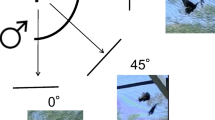Abstract
We investigated the potential roles in behavioral interactions of sexually dichromatic iridescent blue coloration found on the dorsal hindwing of male Pipevine Swallowtails (Battus philenor). Behavioral experiments in a large enclosure addressed whether male dorsal hindwing coloration mediated sexual recognition by males, female choice of mates, or both. Models presented to males in the enclosure produced responses that show that males discriminate females from other males using chemical but not visual cues. In contrast, ablation of male dorsal iridescence significantly reduced male mating success with virgin females in the enclosure. The results support the hypothesis that male-specific iridescent coloration in this species is a signal that is important for females in assessing either male species identity or quality in intersexual interactions.



Similar content being viewed by others
References
Brower JVZ (1958) Experimental studies of mimicry in some North American butterflies. Part II. Battus philenor and Papilio troilus, P. polyxenes, and P. glaucus. Evolution 12:123–136
Codella SDJ, Lederhouse RC (1990) The effect of wing orientation on aposematic signalling in the pipevine swallowtail butterfly, Battus philenor. Anim Behav 40:404–406
Costanzo K, Monteiro A (2007) The use of chemical and visual cues in female choice in the butterfly Bicyclus anynana. Proc R Soc Lond B 274:845–851
Darwin C (1871) The descent of man and selection in relation to sex. John Murray and Sons, London
Fordyce JA, Marion ZH, Shapiro AM (2005) Phenological variation in chemical defense of the pipevine swallowail, Battus philenor. J Chem Ecol 31:2835–2846
Hazel WN, West DA (1979) Environmental control of pupal colour in swallowtail butterflies (Lepidoptera: Papilioninae): Battus philenor L and Papilio polyxenes Fabr. Ecol Entomol 4:393–400
Kemp DJ (2007) Female butterflies prefer males bearing bright iridescent ornamentation. Proc R Soc Lond B 274:1043–1047
Kemp DJ (2008) Female mating biases for bright ultraviolet iridescence in the butterfly Eurema hecabe (Pieridae). Behav Ecol 19:1–8
Kemp DJ, Rutowski RL (2011) The role of coloration in mate choice and sexual interactions in butterflies. Adv Study Behav 43:55–92
Kemp DJ, Wiklund C (2001) Fighting without weaponry: a review of male–male contest competition in butterflies. Behav Ecol Sociobiol 49:429–442
Krebs RA, West DA (1988) Female mate preference and the evolution of female-limited Batesian mimicry. Evolution 42:1101–1104
Lederhouse RC, Scriber JM (1996) Intrasexual selection constrains the evolution of the dorsal color pattern of male Black Swallowtail Butterflies, Papilio polyxenes. Evolution 50:717–722
Maan ME, Cummings ME (2008) Female preferences for aposematic signal components in a polymorphic poison frog. Evolution 62:2334–2345
Montgomerie, R. (2008). CLR, version 1.05. Queen’s University, Kingston, Canada. (available as of 14 December 2011 at http://post.queensu.ca/~mont/color/analyze.html)
Obara Y (1970) Studies on the mating behavior of the white cabbage butterfly. Pieris rapae crucivora Boisduval. III. Near-ultraviolet reflection as the signal of intraspecific communication. Z Vergl Physiol 69:99–116
Rausher MD (1978) Search image for leaf shape in a butterfly. Science 200:1071–1073
Rausher MD (1979) Egg recognition: its advantage to a butterfly. Anim Behav 27:1034–1040
Rausher MD (1981) Host plant selection by Battus philenor butterflies: the roles of predation, nutrition, and plant chemistry. Ecol Monogr 51:1–20
Rutowski RL (1977) The use of visual cues in sexual and species discrimination by males of the small sulphur butterfly Eurema lisa (Lepidoptera, Pieridae). J Comp Psychol 115:61–74
Rutowski RL (1981) Sexual discrimination using visual cues in the checkered white butterfly (Pieris protodice). Z Tierpsychol 55:325–334
Rutowski RL, Alcock J, Carey M (1989) Hilltopping in the Pipevine Swallowtail butterfly (Battus philenor). Ethology 82:244–254
Rutowski RL, Macedonia JM, Merry JW, Morehouse N, Yturralde K, Taylor-Taft L, Gaalema D, Kemp DJ, Papke RS (2007a) Iridescent ultraviolet signaling in the Orange Sulphur butterfly (Colias eurytheme): spatial, temporal, and spectral properties. Biol J Linn Soc 90:349–364
Rutowski RL, Macedonia JM, Kemp DJ, Taylor-Taft L (2007b) Diversity in structural ultraviolet coloration among female sulphur butterflies (Coliadinae, Pieridae). Arthropod Struct Dev 36:280–290
Rutowski RL, Nahm A, Macedonia JM (2010) Iridescent hindwing patches in the pipevine swallowtail: differences in dorsal and ventral surfaces relate to signal function and context. Funct Ecol 24:767–775
Scott JA (1986) The butterflies of North America. Stanford University Press, Stanford
Sherratt TN (2001) The evolution of female-limited polymorphisms in damselflies: a signal detection model. Ecol Lett 4:22–29
Silberglied RE, Taylor ORJ (1978) Ultraviolet reflection and its behavioral role in the courtship of the sulphur butterflies, Colias eurytheme and C. philodice (Lepidoptera, Pieridae). Behav Ecol Sociobiol 3:203–243
Sime K, Feeny P, Haribal M (2000) Sequestration of aristolochic acids by the pipevine swallowtail, Battus philenor (L.): evidence and ecological implications. Chemoecology 10:169–178
Weiss MR (1997) Innate colour preferences and flexible colour learning in the pipevine swallowtail. Anim Behav 53:1043–1052
Wiernasz DC (1995) Male choice on the basis of female melanin pattern in Pieris butterflies. Anim Behav 49:45–51
Wiernasz DC, Kingsolver JG (1992) Wing melanin pattern mediates species recognition in Pieris occidentalis. Anim Behav 43:89–94
Acknowledgements
We thank Kim Pegram, Melissa Lillo, Hanh Han, and Tyler Mello for their assistance in rearing and field work; and especially the Desert Botanical Gardens in Phoenix, Arizona, for generously allowing us to use the butterfly pavilion for these and other experiments. Financial support for this work came from Sigma Xi Grant-in-Aid-of-Research (to PR), the School of Life Sciences Undergraduate Research program at ASU, the National Science Foundation (IOS 1145654 to RLR), and the Undergraduate Science Education Program of the Howard Hughes Medical Institute.
Author information
Authors and Affiliations
Corresponding author
Rights and permissions
About this article
Cite this article
Rutowski, R.L., Rajyaguru, P.K. Male-specific Iridescent Coloration in the Pipevine Swallowtail (Battus philenor) is Used in Mate Choice by Females but not Sexual Discrimination by Males. J Insect Behav 26, 200–211 (2013). https://doi.org/10.1007/s10905-012-9348-2
Revised:
Accepted:
Published:
Issue Date:
DOI: https://doi.org/10.1007/s10905-012-9348-2




